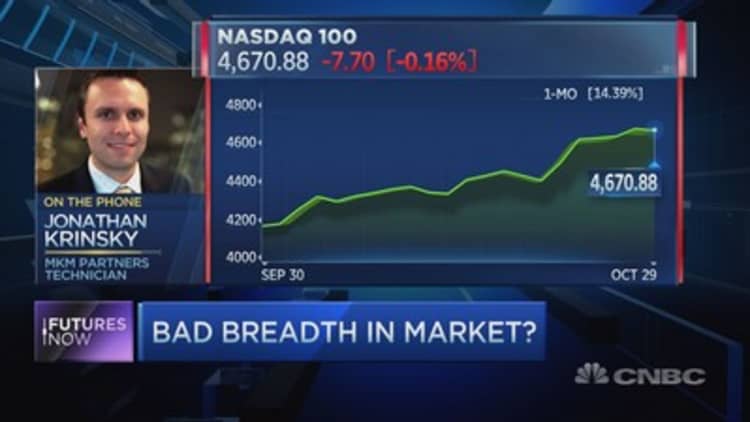
Big cap tech stocks are bubbling.
The has soared more than 14 percent in the last month, putting it within a fraction of its 52-week high and less than 3 percent from its all-time high, hit in the year 2000. The move comes as the broader market has staged a vicious rally in the fourth quarter, but one technician warns that beneath the surface lies the potential for a "substantial" pullback.
"When you look at the Nasdaq 100, it's not really telling the full story," Jonathan Krinsky told CNBC's "Futures Now" on Thursday. The index is up more than 23 percent from its Aug. 24 low.
Looking at a chart of the Nasdaq 100 relative to the equal-weight version of itself, Krinsky noted that while the index is approaching a 52-week high, its counterpart is at a 52-week low. "This is a very unusual setup," added Krinsky. According to the technician, the dispersion is so rare, it has only happened six times since March 2005. In those instances, the returns were largely negative, with the index falling an average of 5 percent in the 10 days to follow. "The next risk is to the downside," he said.
The importance of looking at the equal weight relative to the Nasdaq 100, Krinsky said, is that the index is extremely top-heavy. Apple, Microsoft, Amazon, Alphabet and Facebook make up for more than 35 percent of the Nasdaq 100. "[The equal weight] is basically giving Apple the same worth as a company with the smallest market cap," said MKM Partners' chief market technician. "The risk is that if those stocks weaken even a little bit, the outperformance we've seen becomes undone."
Krinsky also highlighted the Nasdaq's advance-decline, or breadth, has been deteriorating. "On Tuesday the Nasdaq 100 breadth was one of the worst readings we've seen while the index was positive," he said. "This has a high correlation of negative returns in the following month."
Of course, Krinsky noted that it is possible for the stock market to continue to grind higher in the very near term, but nonetheless he believes that internal weakness will eventually catch up and make for a swift sell-off.
"The weight of the evidence and the historical data shows us that there should be a meaningful pullback in the next month."



